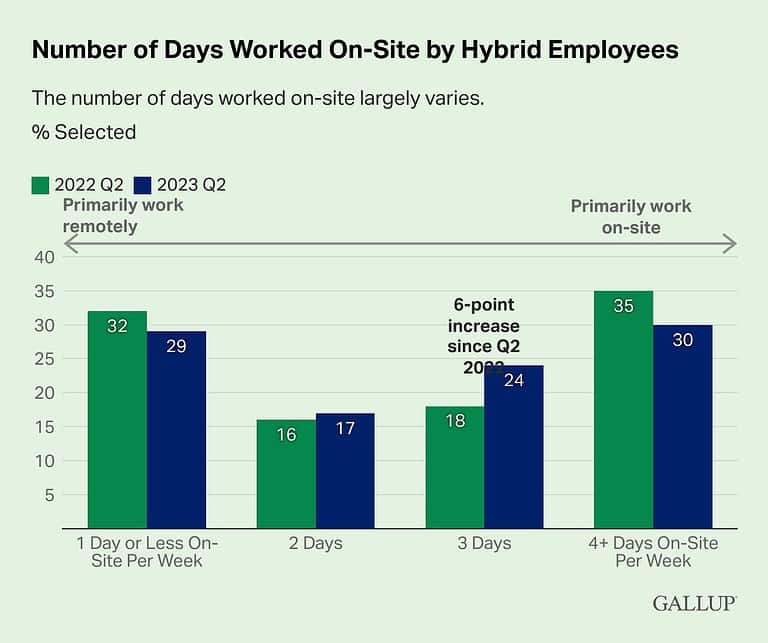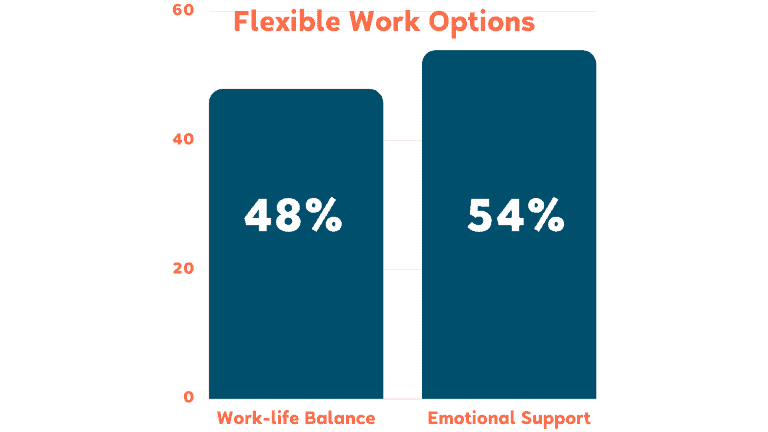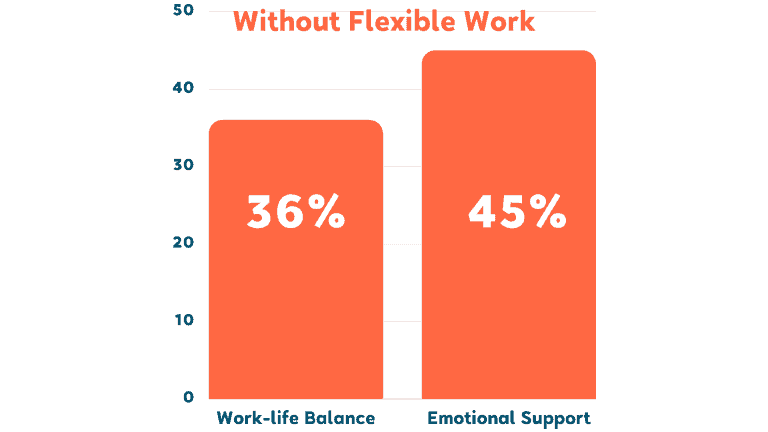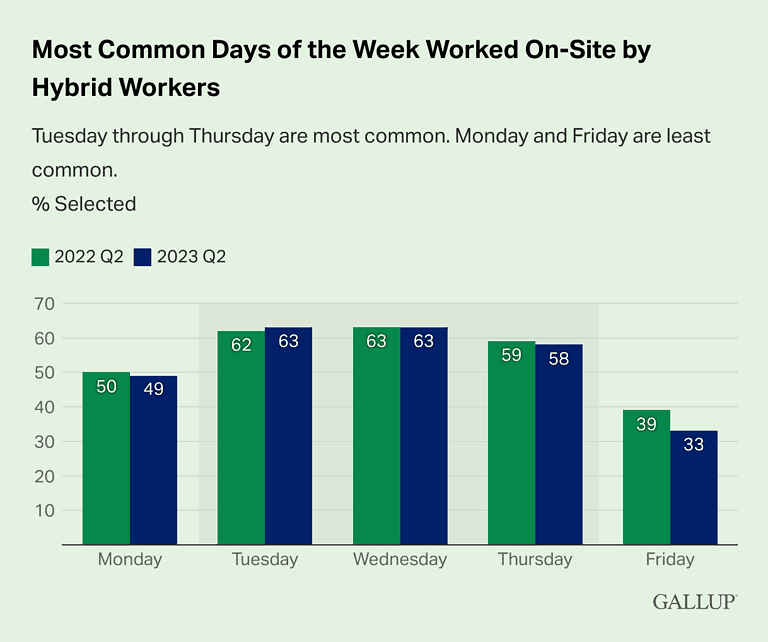Hybrid Remote Meaning
A hybrid role allows you to work from home multiple days each week. You might come into the office most days or just once or twice. Some employers let you choose which days you work remotely and others decide based on company needs.
Workers had to go remote when the COVID-19 pandemic hit. The percentage of remote employees leaped from around 5% in early 2019 to 61% in May 2020. Over the past few years, some companies have returned to a fully in-office experience. Others choose to stay remote. The majority chose to embrace the best features of both work models through hybrid remote roles.
If you’re looking for a new position, you’re likely to find companies that offer hybrid work. Around 90% of employers are transitioning to a hybrid model and it’s easy to see why. The low-stress, high productivity benefits of remote work combine with the clear communication and cohesiveness of an office environment.
History of Hybrid Remote
While the pandemic gave birth to today’s hybrid work environment, the concept isn’t new. Germany implemented “flextime” in the 1960s. It scattered the hours employees had to report in the office, which allowed more mothers and housewives to enter the workforce. The concept helped resolve a labor shortage.
AT&T allowed staff to try an “alternative workplace” model in the 1990s, emphasizing the benefits of hybrid and remote work.
The widespread use of the internet in the early 2000s allowed some computer-based workers to complete some work at home. With wireless internet access, more digital-based organizations began experimenting with hybrid models.
These events helped pave the way for modern work schedules.
Hybrid work describes a work model where employees are expected to attend the office at least one day per week while being permitted to work from a location other than the office some of the time. Hybrid work models vary; for example, offering employees the individual choice or orchestration or scheduling of days in the office for an entire organization or team. Hybrid work can sometimes refer to space, as in “hybrid workplace,” which describes an office that is able to support interactions that successfully include in-person and remote employees.
Gartner Tweet
Remote vs. Hybrid Remote
Is hybrid remote or in-person better than working from home full-time? Possibly. While everyone has their own needs, remote workers often see a dip in productivity when compared to other work models.
You belong to a company and without guidance from leadership, it’s hard to know you’re doing what’s best. For complex scenarios, meeting in person can keep everyone on the same page and boost your confidence in the tasks at hand.
While there are advantages to being in the office, a hybrid environment can remove the stress of the office, creating a nice balance.
Advantages of a Hybrid Remote Environment
There are several reasons to consider implementing a hybrid remote workplace in your company.
Productivity
Though some company leaders worry about the impacts of remote work on productivity, research shows that a hybrid remote schedule can improve workplace efficiency.
In one study of 30,000 employees, researchers found that employees saw a 5% increase in productivity when employees worked remotely. They also found that if you’re productive in the office, you will be productive at home.
You’re also more likely to take fewer sick days when you work from home for part of the week. Germs are most commonly transferred through shared objects like door handles, elevator buttons and desks. The viruses and bacteria can spread illnesses throughout the office, removing several employees for days at a time. You can get sick or get overworked by the number of people taking time off. Less exposure to those surfaces makes it less likely employees will get sick.
When you get to work from home during a portion of the work week, it lowers your chance of succumbing to burnout. Full-time office employees spend the majority of their time commuting to work and performing their duties. It can put significant mental strain which eventually decreases their efficiency. Research found that hybrid workers are twice as likely to stay energized when completing tasks.

Improved Work-Life Balance
Work-life balance is vital to a happy life. It doesn’t come from always spending equal time at both. You achieve it when your mind doesn’t wander away from what’s most important. If you find yourself constantly thinking about home while you’re at work or vice versa, you likely don’t have a healthy balance.
Allowing employees to work from home removes some of the stress of being away from home. While you’re still working, you can also be closer to children, pets and other family members.
The stress of preparing for a day in the office and commuting can take time away from enjoying a family breakfast. Evening traffic and end-of-shift conversations can hinder someone’s ability to make it to events. Providing a hybrid option teaches these conflicts.
A 2022 study found that hybrid employees are 22% happier than those who always work in the office. When you stress less about your work-life balance, it’s easier to achieve it.


Additionally, in a survey with Mental Health America, FlexJobs found that respondents with flexible work options (including remote work) report better mental health. In fact, employees without access to flexible work are nearly two times more likely to have poor or very poor mental health.
Of those who have flexible work options, 48% say their work-life balance is excellent or very good, and 54% have the emotional support they need at work, compared to 36% and 45%, respectively, for respondents without flexible work.
Lower Expenses
Employees aren’t the only ones who benefit from a hybrid schedule. Research shows that your company could annually save $11,000 for each employee who works out of the office for two or three days.
From utilities to transportation, there’s less to worry about when fewer people are using the building each day. Reducing operation costs allows them to improve their bottom line and invest back into your team.

Challenges of Hybrid Remote Workplaces
While there are many advantages to allowing your employees to work partially from home, there are potential disadvantages. Here are some challenges to weigh when deciding on a hybrid remote schedule.
Initial Cost
When an employer offers a hybrid remote schedule, they’ll need to recoup the cost of your home office equipment. You’re probably less likely to try the new routine if you have to pay to retrofit your workspace. It can take anywhere between $500 and $5,000 to purchase equipment for one person’s setup.
Some employers prefer to reimburse you for setting up your office which means you might have to purchase computers, monitors and other needs out of pocket.
Company Culture
When employees are in the office together, they’re more likely to interact and it can be easier to maintain a consistent worker experience. Workers on hybrid schedules — especially if everyone is in the office at different times — can make your company seem less connected and can weaken worker relationships. However, employees who are happier with a hybrid schedule are less likely to engage in heated conflicts that can result in a toxic work environment.
Team Collaboration
Though video conferencing allows for “face-to-face” interactions, it’s hard to replicate the environment of an in-person planning session. If you have more than a few people on a call, you won’t see everyone’s face at the same time, making it hard to pick up on cues of displeasure. Some professionals criticize the hybrid environment as destroying collaboration.
The Demand for Hybrid Remote Roles
More workers recognize the value of hybrid roles and many don’t want to return to the office. The number of employees wanting a full-time office job has decreased over the past few years. The same research found an increase in the employees seeking a remote or hybrid remote position.
Another survey discovered that 68% of employees preferred a hybrid remote environment to in-office or remote work. Companies are noticing the shift and working to accommodate employee desires to secure the best recruits.
Some companies allow you to choose your hours for remote work. Almost half of employers are willing to do so, entrusting you to know when you’ll be most productive. It doesn’t work for every business, but it benefits those able to swing it.
There are plenty of major workplaces that have adapted to a true hybrid remote model and have no intention of eliminating it.
Examples of Successful Hybrid Remote Workplaces
Major companies are embracing the benefits and overcoming the challenges of hybrid remote scheduling. Some of them successfully implemented programs that benefit their employees without disrupting productivity.
Microsoft
Microsoft’s employees can choose to work a hybrid schedule, often without a formal approval process. The company encourages its employees to take advantage of the schedule by covering the expenses used to set up their home office. However, employees who accept the offer will likely lose their permanent spot in the office.
Google’s “Work from Anywhere” program places employees in the office three days a week. They can work from anywhere during other work hours and get four weeks outside of vacation time to work remotely.
Adobe
Adobe now allows employees to spend up to 50% of their working time at home. Employees still need to come into the office for important meetings and other significant gatherings, but say this model makes their employee’s lives easier.
Unilever
The Dove body care and Kraft Foods parent company only requires employees to spend 40% of their time in the office. The company says the strategy is booming and is testing a four-day workweek to improve the employee experience further.
Exploring Hybrid Remote Work Options
Whether you currently work remotely or in a full-time office job, hybrid work is something to consider for the future. Combining the two strategies maximizes benefits for you and your future employers.

